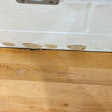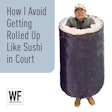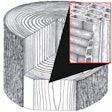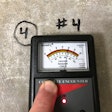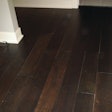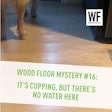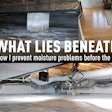The Problem
I received a call from a flooring contractor who could not understand why a portion of the floor he had just refinished was cupping. The house and floor were 18 years old. The 3/4 -by-5-inch select white oak floor had never had any problems until after he completed the sanding and finishing.
The Procedure
The contractor approached this as a common refinish. He sanded following industry standards, then applied an oil-based stain and followed up with an oil-based finish to the manufacturer's guidelines as he had done so many times in the past. A few weeks later, the homeowner called the contractor complaining about cupping in two or three areas.
The Cause
My inspection began with a walk-through with the homeowner. I asked questions regarding plumbing leaks, roof leaks and flooding, and I received a "no" to each of the questions. I used a non-invasive moisture meter along with a large hammer probe to measure the moisture content of the floor. Most of the floor was typical for a well-acclimatized, 18-year-old house in this region: 7 to 8 percent MC. The cupped area measured 16 to 17 percent moisture. Of course cupping would occur with that moisture content, but the question was why! The homeowner mentioned recent landscaping, so a walk around the outside was in order. Everything appeared as it should—good drainage away from the foundation, no puddles, no low spots and no wetness on the side of the house. So, a look underneath was next. Naturally, the crawlspace access was approached after crawling 18 feet under the deck. A brief look in the crawlspace showed a good layer of plastic covering the soil in the crawlspace, but it was dark, so the homeowner got a light bulb to replace the burned out one. As I advanced into the crawlspace to replace the light bulb, I became aware of the extreme softness of the soil under the plastic, like mushy clay. This was the most dramatic soil condition I had ever experienced.
With the light, I was able to see a brand-new HVAC air handler and new ductwork. That was good, but what wasn't so good was that under the HVAC equipment and ducting, the plastic had been removed. There, the soil was hard and dry and showing huge cracks. I measured the MC of the joists and subfloor from below. The area above the soil covered with plastic was normal, however, the area above the exposed soil and new HVAC read 18 to 20 percent moisture. This is why the floor cupped. After measuring the MC in the crawlspace and inside the house, it became apparent that the cupping was confined only to the areas directly over the exposed soil. The homeowner neglected to mention the new HVAC unit, since she didn't think it had any connection to the flooring problem.
How to Fix the Floor
The wood flooring contractor understood that by replacing the missing plastic and drying the floor naturally or aggressively, the flooring would very likely flatten back out. If not, a partial replacement and resanding would be required. The problem was not a result of anything the hardwood flooring contractor had done.
In the Future
This is a good example of the importance of properly covering the soil in crawlspaces with approved plastic. The dramatic difference of the effect on hardwood flooring from covered and uncovered soil under the house is a lesson for all hardwood floor professionals.




















